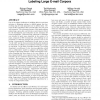Free Online Productivity Tools
i2Speak
i2Symbol
i2OCR
iTex2Img
iWeb2Print
iWeb2Shot
i2Type
iPdf2Split
iPdf2Merge
i2Bopomofo
i2Arabic
i2Style
i2Image
i2PDF
iLatex2Rtf
Sci2ools
CEAS
2006
Springer
2006
Springer
Fast Uncertainty Sampling for Labeling Large E-mail Corpora
One of the biggest challenges in building effective anti-spam solutions is designing systems to defend against the everevolving bag of tricks spammers use to defeat them. Because of this, spam filters that work well today may not work well tomorrow. The adversarial nature of the spam problem makes large, up-to-date, and diverse e-mail corpora critical for the development and evaluation of new anti-spam filtering technologies. Gathering large collections of messages can actually be quite easy, especially in the context of a large, corporate or ISP environment. The challenge is not necessarily in collecting enough mail, however, but in collecting a representative distribution of mail types as seen "in the wild" and in then accurately labeling the hundreds of thousands or millions of accumulated messages as spam or non-spam. In the field of machine learning Uncertainty Sampling is a well-known Active Learning algorithm which uses a collaborative model to minimize the human effo...
Approximate Uncertainty | CEAS 2006 | Conventional Uncertainty Sampling | Internet Technology | Uncertainty Sampling |
| Added | 20 Aug 2010 |
| Updated | 20 Aug 2010 |
| Type | Conference |
| Year | 2006 |
| Where | CEAS |
| Authors | Richard Segal, Ted Markowitz, William Arnold |
Comments (0)

